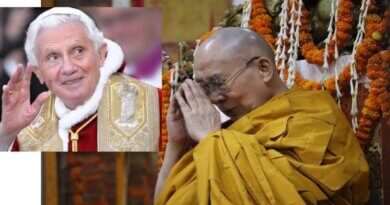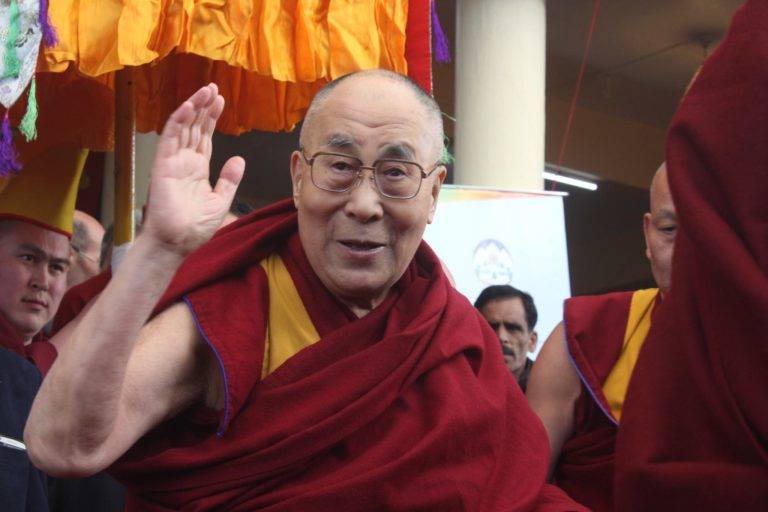A Chinese fraud called “17-Point Agreement”
By VIJAY KRANTI
On 23rd May, Beijing completes 70 years of colonial occupation and rigid communist rule of China. It was on 23rd May 1951 when the Dalai Lama, the ruler and supreme spiritual leader of Tibet, heard a dramatic broadcast on ‘Radio Peking’ which announced that Tibet had signed a “17-Point Agreement” with China under which Tibet had agreed to become a part of China. Amidst shouts of self-congratulation the Radio claimed that the ‘Agreement’ had been signed between the ‘Central People’s Government’ of China and the Tibetan delegates ‘with full powers of the Local Government of Tibet’.
The 16-year-old Dalai Lama, ruler and supreme spiritual leader of Tibet, was, for a moment, too shocked and dumb-struck to grasp this development. What China was claiming to be the ‘delegates with full powers’ of Tibetan government was just a five-member group of low-ranking Tibetan officials. In the wake of China’s threatening attitude following the People’s Liberation Army’s (PLA) attack on Eastern Tibet in the previous October, the Dalai Lama had sent this delegation to Peking (now ‘Beijing’) a few days earlier, only for the purpose of finding out from the Chinese leader how Tibet and China could keep living peacefully as good neighbours. The ‘delegation’ had neither authority to sign any agreement nor were they accompanied by any state seals.
Narrating his experience of that fateful evening in his autobiography Freedom in Exile, the Dalai Lama says, “I could not believe my ears. I wanted to rush out and call everybody in, but I sat transfixed…. I felt physically ill as I listened to this unbelievable mixture of lies and fanciful clichés.” Referring to what some members of the Tibetan delegation narrated later, he says, “They were forced to sign the ‘Agreement’ under duress and to use counterfeit seals of the Tibetan state.”
The very first clause of this ‘Seventeen-Point Agreement’ announced that “The Tibetan people shall unite and drive out imperialist aggressive forces from Tibet; the Tibetan people shall return to the family of the Motherland — the People’s Republic of China.” Reacting to the Chinese idea of driving out “imperialist aggressive forces from Tibet”, the Dalai Lama recalls that at that time only a handful of foreigners were present in Tibet, and that the last foreign army to have been stationed on Tibetan soil was the Manchu army which had invaded Lhasa in 1910 but was thrown out in 1912 with the fall of the Manchu empire in China. “And the idea of Tibet ‘returning to the Motherland’ was a shameless invention. Tibet had never been part of China. In fact …… Tibet has ancient claims to large parts of China,” writes Dalai Lama in his autobiography.
Ironically the very first of the operative clauses, i.e. Clause 2 of the said “17-Point Agreement”, exposes China’s status as an ‘outsider’ in Tibet. It promised on behalf of the Tibetan government that it shall “actively assist the PLA to enter Tibet and consolidate the national defence.” The rest of the clauses of the ‘agreement’ included high-flying promises from China to Tibet which China has broken overwhelmingly and with full force throughout the past 70 years. These promises included the Tibetan people’s right to exercise ‘national regional autonomy’; no alteration in the position and powers of the Dalai Lama and his officials; respect for the Tibetan people’s religious beliefs, customs, and habits; development of Tibetan language and education; development of agriculture, livestock, industry, and commerce of Tibet; and providing funds from the ‘Central People’s Government’ for the military and administration in Tibet. One clause specifically promised freedom to the ‘Local Government of Tibet’ to carry out reforms of its own accord. Another important clause promised that the PLA in Tibet “shall be fair in all buying and selling and shall not arbitrarily take a single needle or thread from the people” of Tibet.
However, when it came to implementation of this agreement, which was drafted by the Communist leaders of China themselves, it has been more observed in the breaking of each point ruthlessly over the past 70 years. For example, all powers of the Dalai Lama and his cabinet were taken away in one stroke by the Communist Party, and most of the monasteries were looted and occupied by the PLA to accommodate its ever-increasing military force. Later, almost all of these monasteries were destroyed during the Cultural Revolution decade.
Interestingly, Beijing’s promise that the PLA would not take away ‘a single needle or thread’ from the Tibetan people was religiously observed by the PLA by forcefully grabbing everything else. A major reason for the Tibetan uprising against the Chinese rule over Tibet, which finally ended up in a huge massacre and the escape of Dalai Lama to India in March 1959, was the famine caused by catastrophic confiscation and shifting of food from Tibet to China where Chairman Mao’s “Great Leap Forward” (1958-1960) had played havoc with China’s agriculture and industry. According to estimates, claimed by exile Tibetans and supported by most human rights observers, Tibet lost over 1.2 million lives, viz one-fifth of its population, during the first three decades of occupation.
Over the past 70 years, Beijing has been claiming its occupation of Tibet as ‘peaceful liberation’. Even today the Beijing rulers of Tibet leave no opportunity on national and international forums to claim that they have spent billions of dollars in developing Tibet to upgrade the living standards of Tibetan people. But the reality remains that all this ‘development’ and spending has been focused exclusively on building up a mammoth Chinese military infrastructure across Tibet to intimidate neighboring South Asian countries, especially India. A substantial part of this money is being spent on the development of new cities and towns across Tibet to facilitate millions of new Han Chinese settlers to settle permanently all over occupied Tibet.
Despite all these Chinese claims, China’s human rights record in Tibet has been judged to be extraordinarily poor. Over the past many decades, many leading international organizations — right from the UN-associated International Commission of Jurists in 1959 to the present-day Amnesty International and Human Rights Watch, have underlined that Chinese colonial rule over Tibet is one of the worst examples of genocide, human rights violations, and torture in modern world history. ‘Freedom House’ a prominent human rights watch group of the US has, in its latest report, judged Tibet to be “the second least-free country in the world, behind only Syria.” In its latest report on China, Human Rights Watch has observed, “Authorities in Tibetan areas continue to severely restrict religious freedom, speech, movement, and assembly, and fail to redress popular concerns about mining and land grabs by local officials, which often involve intimidation and unlawful use of force by security forces.”
In its very first report, titled “The Question of Tibet and the Rule of Law”, presented to the United Nations in 1959, the International Commission of Jurists had presented details of the violence and genocide committed by China’s People Liberation Army in Tibet, especially during the uprising of the Tibetan people against the colonial Chinese rule. Referring to widespread mass killings by the PLA following the escape of the Dalai Lama from his Norbulingka Palace in Lhasa, it stated, “There has also been a systematic policy of killing, imprisonment, and deportation of those opposed to the regime. According to reliable sources, the total number of persons so far fallen victim to the mass killing amounts to a colossal total of 65,000.”
Giving some gory details of China’s policy of religious repression in Tibet it said, “Freedom of religion has been and is denied to the Tibetans. The Chinese authorities have been attempting to destroy the Buddhist religion of the Tibetans and their faith and also their monasteries, shrines and monuments. A large scale policy of Communist indoctrination and an abusive anti-religious propaganda have also been launched.” Unfortunately, this anti-religion and anti-human rights campaign of China in Tibet has only gained momentum and severity over the years since this report of ICJ in 1959.
Recently the Central Tibetan Administration (CTA), established by the Dalai Lama soon after his escape to exile in India in 1959, has asked the United Nations Human Rights Council (UNHRC) to hold a special session on “human right violations” by China in Tibet and other regions under it. Accusing China of committing “cultural genocide” in Tibet, the CTA asked UNHRC to “act with a sense of urgency” to “ensure that China fulfills its obligations under international laws including human rights obligations before it is too late”.
However, it is difficult to believe that the United Nations or its agencies like the UNHRC hold any big promise for Tibet or other colonies of China like Xinjiang and South Mongolia, or even for Hong Kong. Over the past few decades Beijing has successfully used its economic and military muscle to win number games in most such international forums, especially those belonging to the UN. For example, over the past three decades China has been successful in buying out or hijacking the votes of crucial voting states in such forums. In most cases, it was done through direct financial aid and by giving massive loans to governments which had no capacities to repay or even service those loans. In many cases Beijing has been directly influencing pliable leadership of these countries though bribes or blackmail.
For example all 12 UNHCR resolutions critical of China’s human rights record between 1990 and 2005 were defeated. In the years following 2013 and after the emergence of Xi Jinping as President of China, the capacity of China to push back on any criticism on its human rights record has rather increased inversely to its deteriorating records in Tibet, Xinjiang, South Mongolia, and Hong Kong. Even a vote on whether to discuss China itself has been defeated on almost all occasions.
However, the increasing belligerence of China in recent years, especially its opaqueness regarding the spread of the deadly Wuhan virus around the world, is a new situation which has the potential to be the battle of Waterloo for China’s communist leaders. Gradually increasing international anger against China and the emergence of new anti-China international platforms like the QUAD give a positive hope to China’s helpless colonies like Tibet.

The author is a senior journalist and a Tibetologist. he is presently the Chairman of the Centre for Himalayan Asia Studies and Engagement, New Delhi. He can be contacted at v.kranti@gmail.com and www.vijaykranti.com.
The views expressed in this piece are that of the author and should not be attributed to the website.





